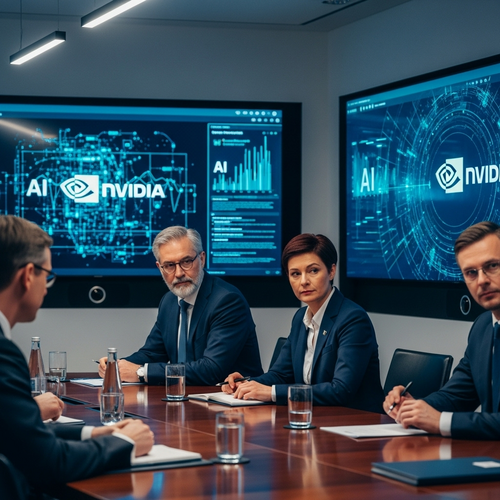
AI has changed the way countries build their future through innovation, to say the least. Nvidia just dropped a huge piece of news that might shift how Europe’s AI Future tackles everything from machine learning to government tech strategy. If you’re into advanced calculations, predictive modeling, or just curious about who’s pushing limits in AI, this should be on your radar.
What’s Going On With Nvidia in Europe?
Nvidia is taking some serious steps in the region. They’ve teamed up with different European governments and top research outfits to launch Blackwell-powered AI data centers and jumpstart European AI supercomputing projects. If you ask me, this isn’t something you see every day.
Honestly, I feel like this move isn’t just about selling tech. It’s more about shaping the way AI infrastructure in Europe looks—giving it more backbone, more depth, and a touch of that Nvidia polish.
Presentation to the Blackwell Platform

First things first, what’s Blackwell? It’s Nvidia’s newest chip architecture, tailored for advanced AI workloads. These processors are built to speed things up while keeping power usage in check—something a lot of data centers care about today.
The chips can manage gigantic AI models, driving smarter applications, automation, and even AI security initiatives across Europe. And if you’ve been following industry tech closely, then you know Blackwell was built with tasks like predictive dialing, natural language processing, and advanced simulations in mind.
What Exactly Makes Blackwell Stand Out?
Let’s break it down. Blackwell’s architecture brings together multiple units with focused computational power. This alignment gives servers and data centers a real kick when it comes to training AI models and running them in real-time (yep, I said it).
Also, the Blackwell chips work well with Nvidia’s network setups, which means systems that used to stutter under pressure now breathe easier. I could be wrong, but I kinda get the vibe that this might lead to faster European deployments in tech, healthcare, energy, and even digital governance.
AI Infrastructure Development in Germany and the UK

The way I see it, both Germany and the United Kingdom are doubling down on AI infrastructure in a way that seems more long-term than reactive. And Nvidia’s smack-dab in the middle of it.
Germany is already home to a growing AI scene, especially in places like Munich and Berlin. With Nvidia’s help, they’re rolling out GPU-based AI infrastructure that can host massive training loads, from autonomous vehicles to medical diagnostics.
The UK, meanwhile, is leaning toward public-private collaborations. Ever heard of AI supercomputing clusters happening near Cambridge? That’s one of the illustrations of this approach—something that could help small companies, startups, and government labs scale up without footing the bill for server farms.
This Might Sound Weird, But Europe’s Playing It Smart
By pulling in Nvidia and combining local funding and strategy, Europe’s getting the best of both worlds—global innovation plus homegrown momentum. Not gonna lie, that mix is kinda refreshing.
Nvidia Partnerships With European Governments

Let’s be real—governments don’t always jump on tech partnerships quickly. But in this case, there’s a sense of urgency. Nvidia’s deal with the UK and Germany includes long-term project rollouts, infrastructure lending, and tech knowledge transfer. Call it what you want, but this isn’t a surface-level handshake.
Moreover, Nvidia’s collaborating with high-level educational institutions and national labs. For what it’s worth, that’s an illustration of how this isn’t just about tomorrow’s AI tools—it’s about setting up future-proof AI education and skill-building too.
Europe’s AI Future Supercomputing Projects on Blackwell Tech

Now here’s where it gets serious—but also really cool.
Europe’s top AI supercomputing projects, like the ones in Italy’s Leonardo lab and Finland’s LUMI installation, are starting to lean into Blackwell-powered systems. What precisely sets Blackwell apart from the swarm is how easily it plugs into large processing arrays without causing chaos. It reads like a system built to scale.
These projects aren’t just for researchers in lab coats. They’re being used in areas like health prediction models, energy savings estimates, AI security frameworks, and even multilingual AI systems that serve public sectors.
Let’s Talk Actual Performance
Blackwell chips have smart scheduling engines that can conserve power without losing performance. That means fewer overheating issues and more streamlined data processing. In plain English, they let these supercomputers crunch bigger data sets without a meltdown—literally.
Private and Public Sector—Working Together

I think this is something Europe deserves credit for. They’re not just waiting for startups to innovate or asking universities to invent something. Instead, they’re giving room for both private companies and government groups to get involved.
Additionally, Nvidia’s tech isn’t locked behind paywalls or monopolized by single contracts. Instead, it flows through shared infrastructure—something any AI-focused startup would definitely appreciate in these expensive times.
Who’s Gonna Benefit from All This?
If you’re a company building AI models, a university managing digital research, or just someone interested in better digital government—it’s probably you. These setups are designed to support everything from CRM integration for enterprises to real-time predictive support in healthcare systems.
How This Changes the Future, in My Opinion

Well… it depends. But if Europe keeps moving this way, backed by international tech like Nvidia’s, then I’d say global players better keep their eyes open.
This might sound odd, but AI infrastructure development in Germany and the UK could influence the digital roadmap across neighboring countries. If Sweden, France, or Spain decide to hop onboard, things could get very, very interesting.
Frequently Asked Questions
Nvidia’s working with European governments and labs to set up Blackwell-powered AI infrastructure and help roll out powerful AI supercomputers in Germany, the UK, and beyond.
They’re designed for heavy AI workloads like advanced modeling, prediction systems, and real-time inference. Ideal for companies and governments running scalable projects.
Definitely not just research. Businesses benefit through shared infrastructure, faster models, and support for CRM integration and data analysis tasks.
They’re leading the charge on AI infrastructure development, with funding going into public-private partnerships that could drive growth in the entire tech ecosystem.
Yes, especially if EU-wide funding continues. Also, Nvidia’s approach allows smaller players to tap into existing infrastructure without major investments.
Final Thoughts
So, where does this leave Europe? Right now, with stronger partnerships, smarter tech adoption, and AI infrastructure ready to take on the world—it’s looking promising.
Maybe it’s just me, but I think Nvidia has just laid the foundation for Europe to lead in AI (and not just play catch-up).
If you’re into user experience, digital architecture, or wondering how Blackwell chips could transform your workflow, it might be time to explore a bit more.
Curious about how this affects your industry? Drop your thoughts or questions below. Or better yet, challenge your current tech stack by digging into what this AI wave might unlock for you.




